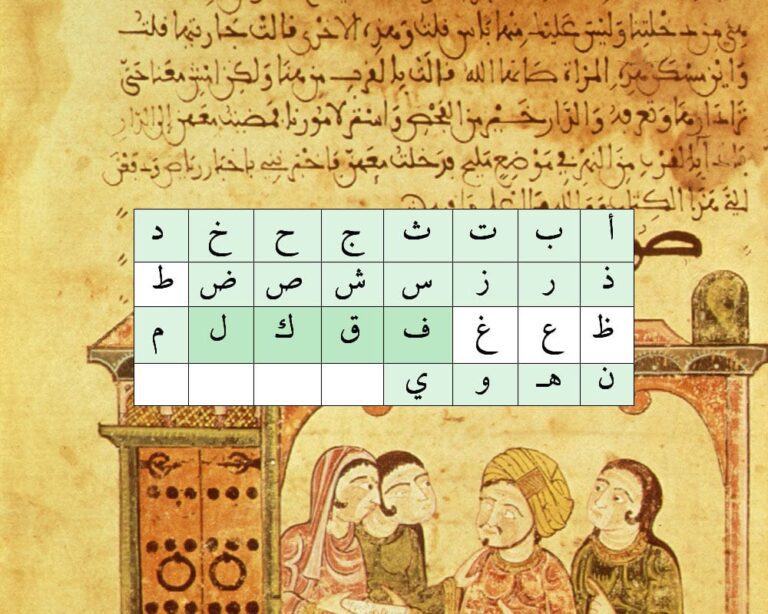Today, another fairly short lesson, with just four letters – letters that are used a lot. The writing is very easy, but the pronunciation is going to be a bit tricky, with the guttural K… Our board is getting greener and greener, which is normal, as we’re on the penultimate lesson.
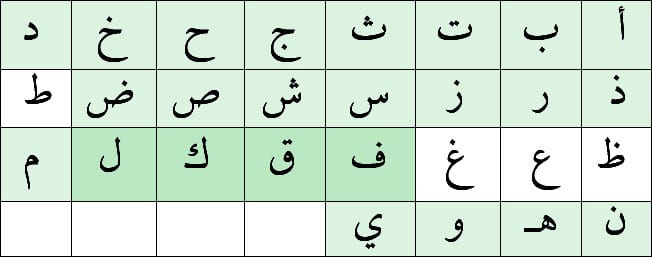
One of these letters, Lâm, is useful for many words, so we’re going to have a nice ‘vocabulary and writing’ section.
The ف : the F sound
A very simple letter, pronounced like in English. It is, like the , a loop, but it is also above the line, and with a ligature, the line to the left, very elongated. The mistake not to make? Putting the little circle on the line, like an inverted e. There is virtually nothing to distinguish it from و at this point. You just need to place it a little higher up so that its shape is recognisable.
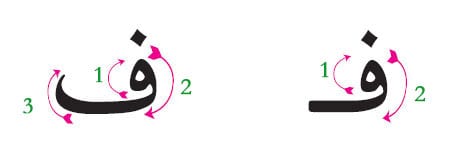
The ق : Qâf
Et hop, à nouveau une gutturale, une emphatique, c’est une des trois lettres que j’ai le plus de mal à prononcer, un K qu’il faut faire exploser du fond de la gorge. Et pour mon malheur… il est très utilisé en arabe ! C’est exactement la même façon de le tracer que le Fâ, mais avec deux points !
The ك : Kaf
C’est le K “français”, normal. Il a une forme un peu compliquée, en finale et tout seul, qui s’écrit “à la main” comme elle s’imprime, et une très jolie forme de S anguleux quand il est lié à une autre lettre. Il ne s’attache jamais à la lettre précédente (donc sur la droite).
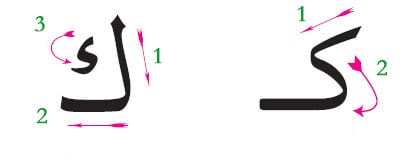
The ل : Lâm
This is our L. A stick that ends in a loop, to differentiate it from the. The other important difference is that when it is in a word, it attaches to the letter that follows it (i.e. to the left), which is not the case with Alif , which is one of the orphan letters.
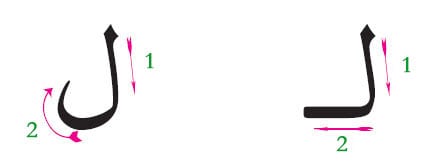
Another peculiarity of the Lâm: precisely, with the أ . In the sense ا then ل , it’s easy. This is how you write the post, أل , it makes two separate and clearly identifiable sticks, the ل with its downward curve, and the أ with its little sign above it, the hamza, which we’ll see soon.
But in the other direction, it makes like a very narrow U and very elongated upwards, and it’s not pretty, and then it could be confused with other letters, like the or the when they’re distorted for calligraphy.
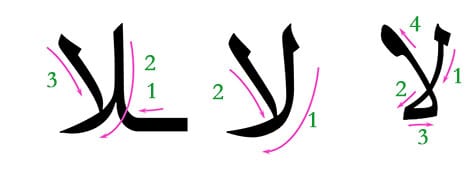
So we have a very special shape, called the Lâm-Alif: the two letters cross to form a small triangle لأ . And just like the أ , the Lâm-Alif does not join the letter that follows it!
The two ‘firsts’ (on the right, never forget that Arabic is written from right to left) are two versions of the spelling alone or in initial position. The third (on the left) is linked to the previous letter. You can also link the Lam Alif written with a triangle. So it’s up to you to choose what’s easiest for you!
Words, words, words…
سلام
Peace. . A word we hear 10 times a day, at least, in the expression السلام عليكم , literally ‘peace be upon you’ [Salam Aleykoum], and which we use to greet each other. And you see the lovely Lâm Alif.
Un prénom féminin : ليلة
ليلة , transcribed as Leyla or Leïla, means the night.
Another very common girl’s name: فاطمة
Fatima, you’ve heard it before… now you know how to write it! … and pronounce it
The moon قمر
In the previous lesson, we learnt شمس , the sun. Here’s his girlfriend, the moon (and yes, there are lunar letters too, see you in three or four lessons).
قف, stop, danger !
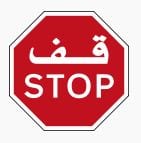
That’s the word you see on the stop signs… Qaf and Fa at the same time, to remember it well.
A series of prepositions?
Come on, a little courage, a first contact with words that we’ll be seeing again and again
في : in
تحت : under
فوق : over
قنل : before
من : from (in the sense of originating from, coming from)
And to finish, we continue the family with:
Brother أخ and sister أخت
(In the same way that we often call a younger woman تبتي , we may call someone of their generation أخ or أختي without even knowing them. In a café, you’ll often hear أخ called, it’s not because the waiter is related to the customers, but simply the way they’re called. It’s nicer, isn’t it? ) and .Of course, to say ‘my sister’ we add the Ya:أختي
Finally, a riddle
This is a famous brand… كوكا كولا can you identify it? In Arabic, there is no ‘o’ and we use و to transcribe it.
 A typo or syntax error? You can select the text and hit Ctrl+Enter to send us a message. Thank you! If this post interested you, maybe you can also leave a comment. We'd love to exchange with you !
A typo or syntax error? You can select the text and hit Ctrl+Enter to send us a message. Thank you! If this post interested you, maybe you can also leave a comment. We'd love to exchange with you !

